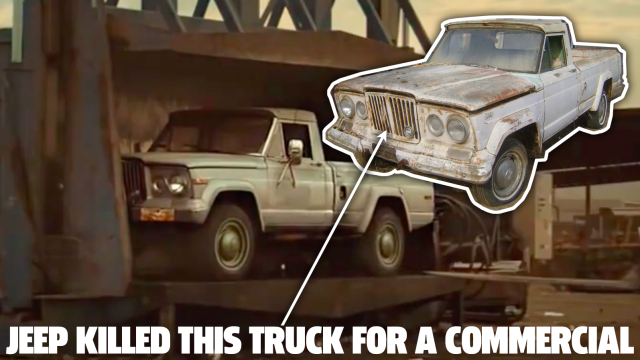Last year, Jeep aired a commercial showing a scrapyard crushing a classic 1963 Jeep Gladiator. In the ad, the old truck’s crinkled sheetmetal morphs into the new 2019 Jeep Gladiator, which destroys the hydraulic press in a display of toughness. Unfortunately, a real, restorable 1963 Gladiator gave its life for this commercial, and I recently heard from the man that truck belonged to. Here’s his story.
This Jeep Gladiator commercial, shown below, made headlines when Jeep enthusiasts criticised the brand for crushing a vintage truck that appeared to be in decent condition. “Fans upset at Jeep for ‘killing a unicorn’ in commercial for new Gladiator pickup” was the Fox News headline. TFL Truck’s words on the matter: “2020 Jeep Gladiator ‘Crusher’ Super Bowl Commercial Might Crush Your Soul.” (Note that the commercial didn’t air during the Super Bowl, though it’s not clear if the controversy contributed to that choice.)
Fox’s story quoted a number of commenters who wrote things like “If they really crushed an older Jeep they should be put in jail for treason,” and “Well, that was horrifying… If this wasn’t CGI then it’s a travesty” and “Looked pretty complete and straight, whatever was wrong with it someone would have saved it.”

Jeep responded to the criticism on YouTube, writing: “We feel you. However, the older Gladiator in the video was unsalvageable and was sourced via an online scrap sales site.” The brand confirmed the model year in a comment to Motor Trend, stating: “The inoperable 1963 Jeep Gladiator depicted was sourced via an online scrap sales site. We wish we could have driven it while it was still alive!”
Recently, a reader claiming to have been the former owner of the very 1963 Jeep Gladiator destroyed in the controversial commercial, aptly titled “Crusher,” sent me an email. That man’s name is Loren (he preferred that we not use his last name), and he told me that contrary to Jeep’s YouTube comment, the truck was offered for sale on Craigslist, not a scrap sales site, and the vehicle was far from unsalvageable, though it was missing its title.
(It’s worth mentioning the slim possibility that the person who bought the truck from Loren ended up making the machine unsalvageable and then selling it on a scrap site before Jeep took ownership of it. This is unlikely because of the buyer’s background. More on that in a bit).
“Yes it was an inoperable Jeep,” Loren, who is a professional metal fabricator, admitted to me in an email, “but it was by all means restorable.” Looking at the photos he sent, I agree.
The Truck Was Imperfect, But Beautiful
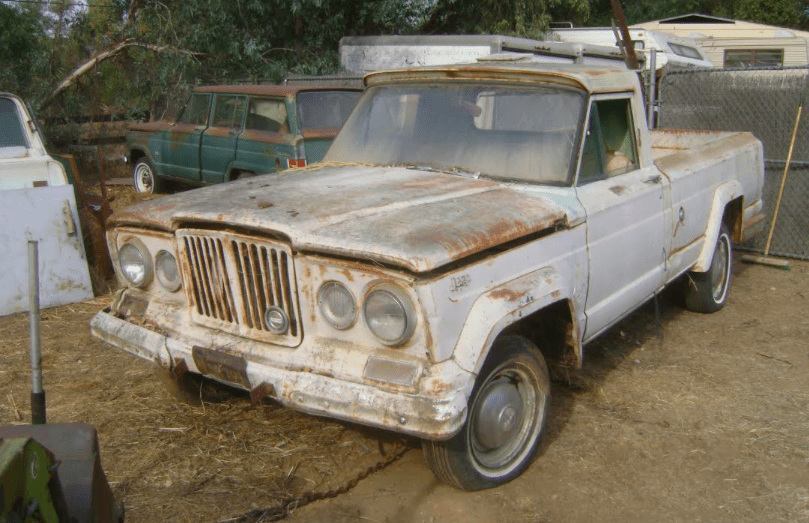
As a Jeep SJ-platform connoisseur myself, I can say without question that Loren’s 1963 Jeep Gladiator was a good candidate for restoration, barring any unsolvable title issues. Located out West, its body appeared free of major rust or dents, the powertrain was complete, and the grille, lights and three-piece front bumper looked to be all there.
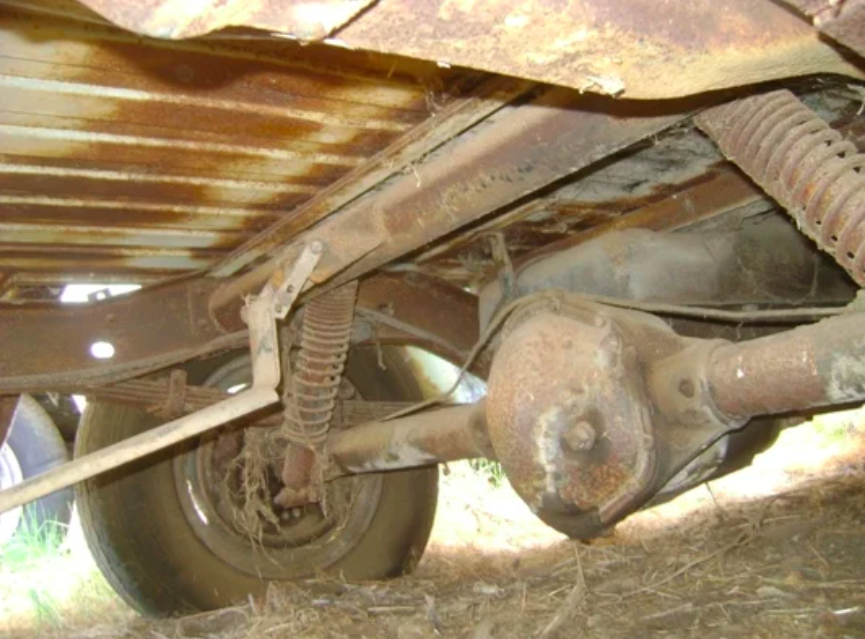
Not to mention, this truck was originally Forest Service Green, the greatest paint job ever, and a cool bit of pedigree. Also, this pickup was one of the very few to have been built as a Willys (in 1963, the truck’s first model year, Willys Motors became Kaiser Jeep Corporation). This was just a cool machine; to see a rare and restorable former Forest Service Jeep truck die by way of a crusher — for a TV commercial — is just sad.
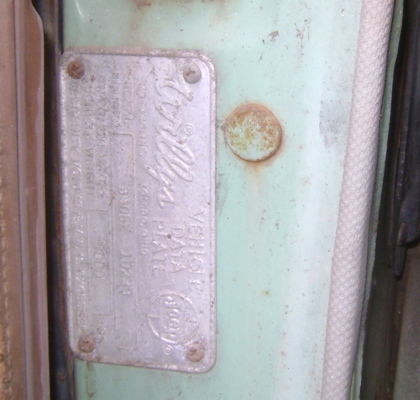
To be sure, restoring the truck wouldn’t have been easy. Obviously, the whole thing needed paint work, and there were rust holes that needed to be addressed, like this one in the hood:
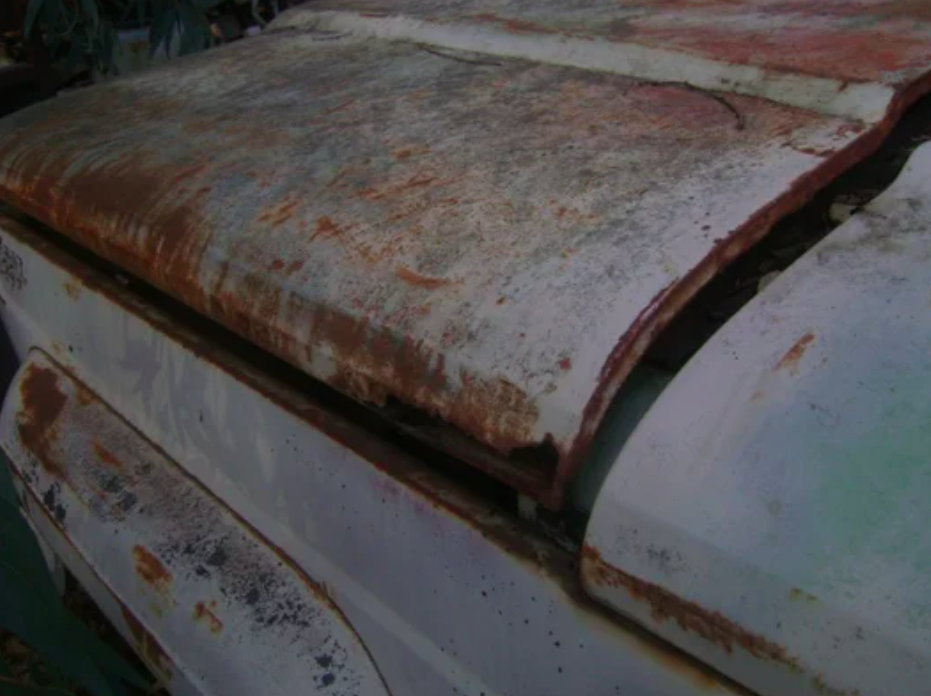
The doors didn’t even match, though Loren swapped on matching closures prior to sale.
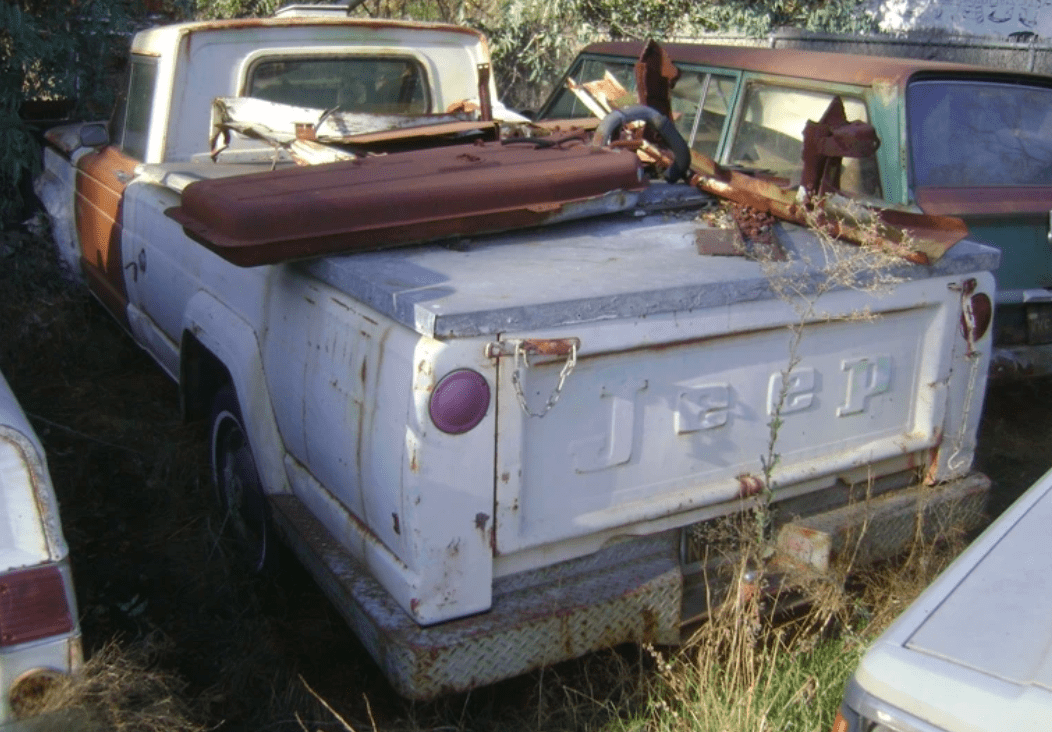
One of the photos from the Craigslist ad, below, doesn’t exactly inspire confidence in how well those doors were secured to the body, though I assume Loren fixed that when he swapped on the white ones. In any case, the image also shows some floorboard rust:
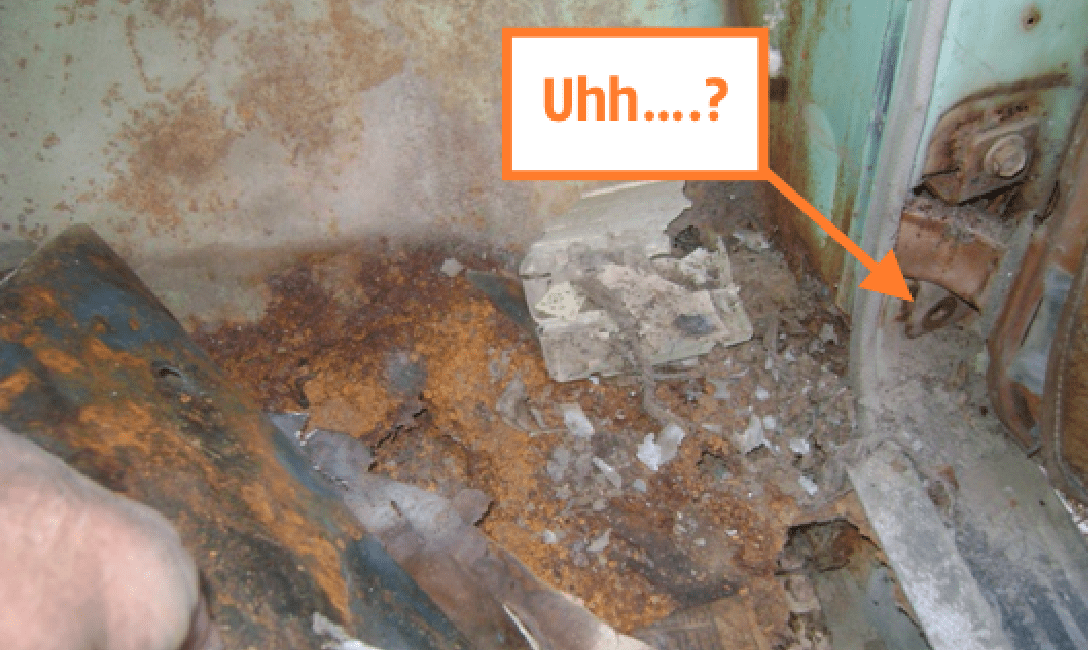
Though it’s worth noting that the driver’s side floor seemed mostly ok aside from some surface rust:
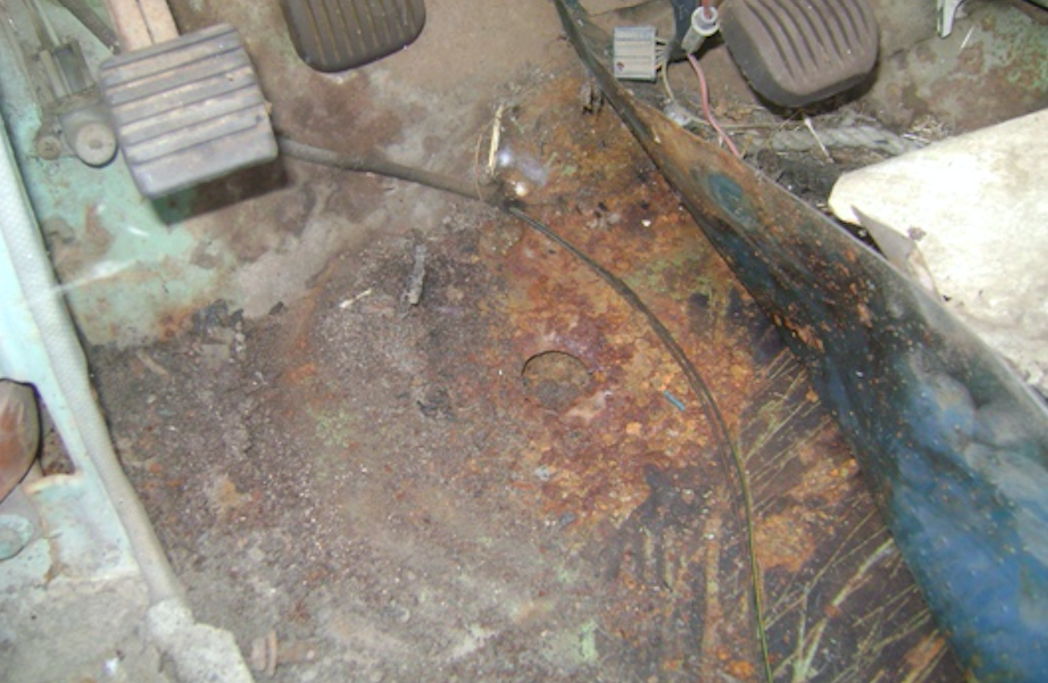
The rest of the interior was fairly trashed, with no gauge cluster or radio to be found, and some serious cracks in the steering wheel:
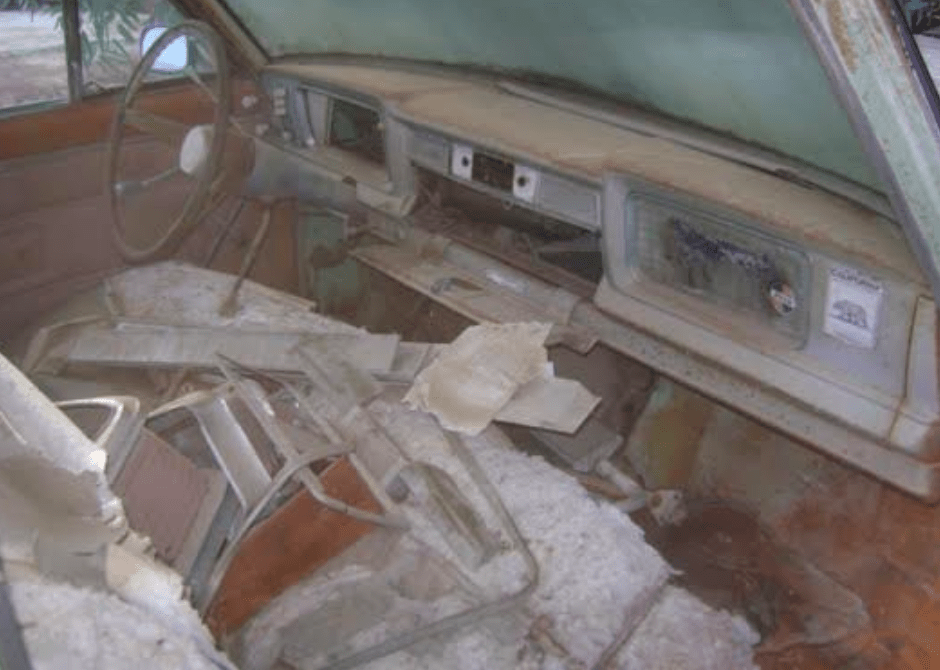
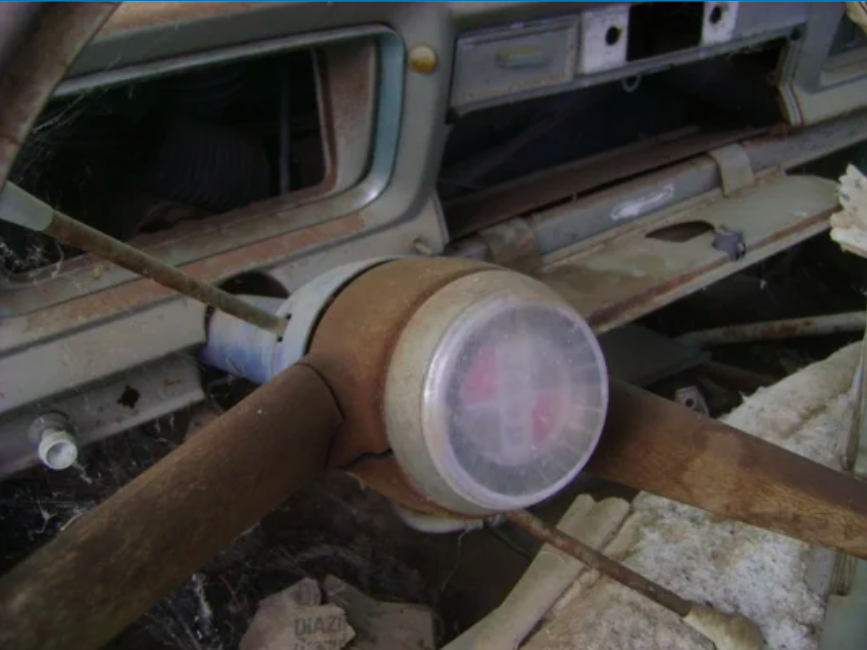
Arguably the biggest problem with Loren’s 1963 Jeep Gladiator was the fact that it didn’t have a title. That’s annoying at best and a deal-breaker for many, though Loren tells me that getting a title for this truck isn’t likely to have been that difficult.
So even though the truck’s body was decent, and it was mostly complete, the reality is that getting this 1963 Jeep truck back up to snuff would have been a job and a half, requiring paperwork, welding, plenty of paint work, sourcing of a gauge cluster and radio, new upholstery and quite a bit of wrenching on that motor and transmission.
Still, seeing something so rare and timeless — and with true potential — get destroyed, especially when in the worst case it could have donated parts to another old Gladiator in need, is tough on the heart. Especially on that of Loren, who tells his full story of the now-dead Gladiator below. Before we get into that, though, let’s analyse the commercial frame by frame to see if we can spot Loren’s truck.
A Closer Look At The Commercial
In an opening scene, a forklift is carrying a truck that is clearly different from Loren’s. Unlike Loren’s 1963 Gladiator, the pickup on the forklift has wide trailer-tow mirrors, a winch bumper, side markers, a different rear bumper and — the major giveaway — a large rear window. (I mention this as the major giveaway because one could have modified Loren’s truck with the other parts, but modifying it to have a large rear window would have been highly labour-intensive).
Looking at it closely, especially at the hubcaps, I’d guess this truck is CGI, at least to some degree.
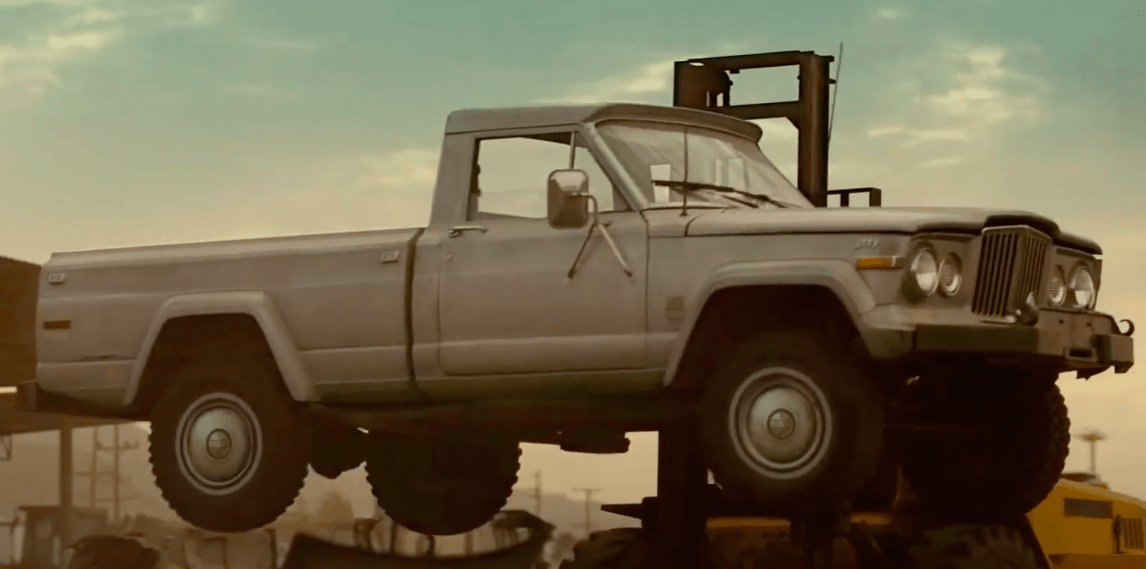
A bit later in the commercial, we see a truck interior that does not match the cabin of Loren’s former truck. You’ll notice the presence of a gauge cluster, a completely different steering wheel and a large rear window. By contrast, Loren’s truck has no gauges, a three-spoke wheel and a small rear window.
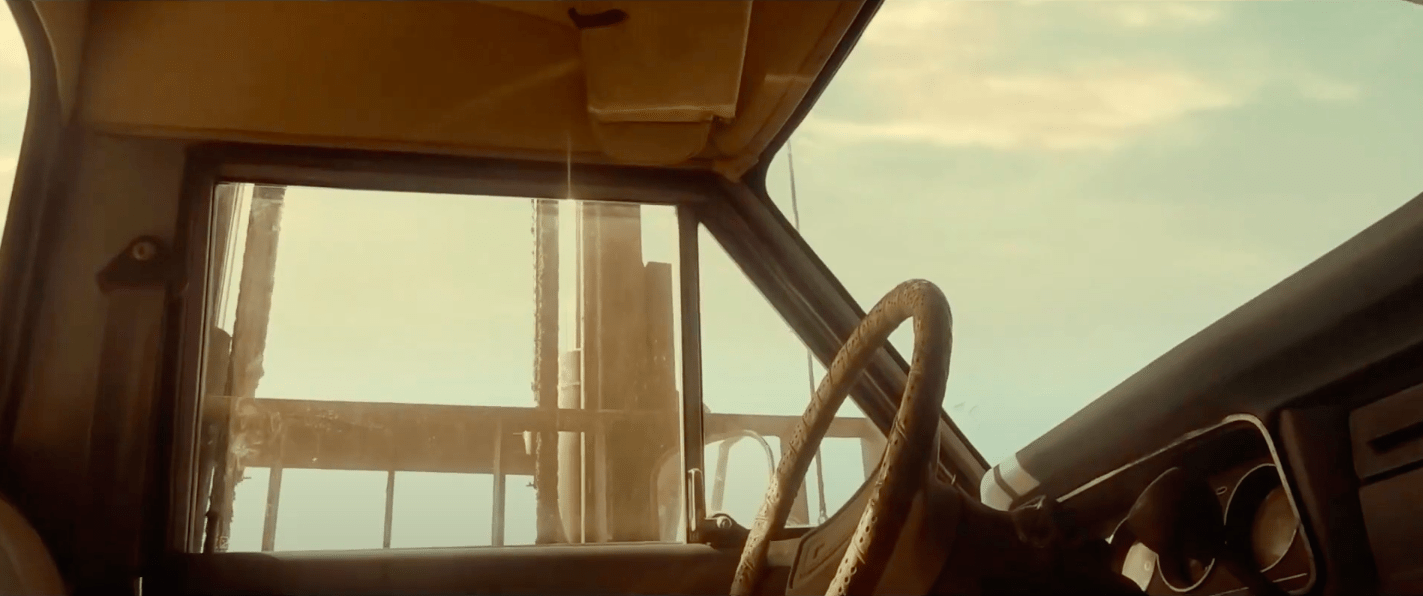
Clearly, this vehicle, a 1970s-era truck, acted as a stand-in for some of the shots in Jeep’s commercial. Perhaps it was a second vehicle crushed for the spot, or perhaps this one was all CGI; I’m not sure.
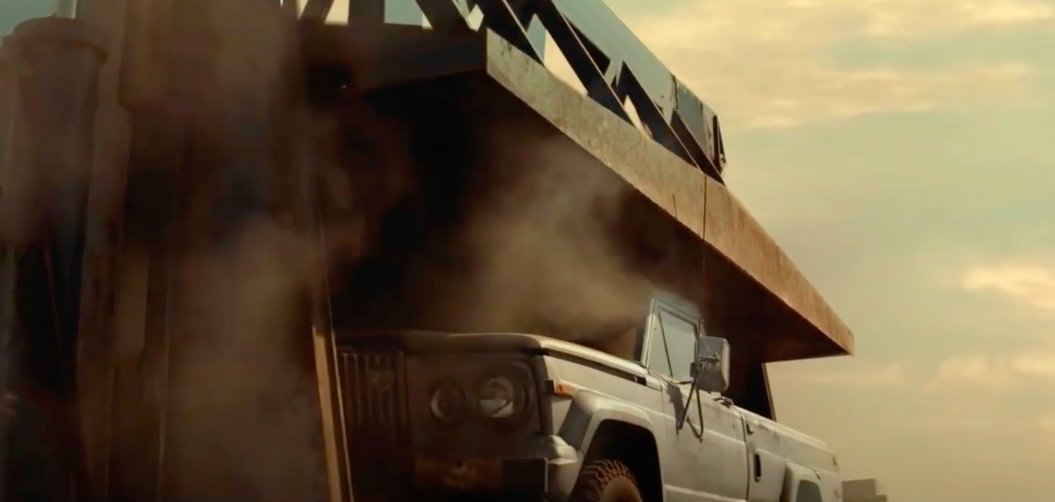
Once the forklift drops the truck onto the press platform to be crushed, it’s clear that we’re still not looking at Loren’s 1963 machine. The fuel tank filler location is a black rectangular shape on the bedside instead of a silver circular filler as on older Jeep trucks like Loren’s; there are still side markers visible; there’s a big mirror where Loren’s truck had none; and the tires are different.
But then in the next scene, things change:
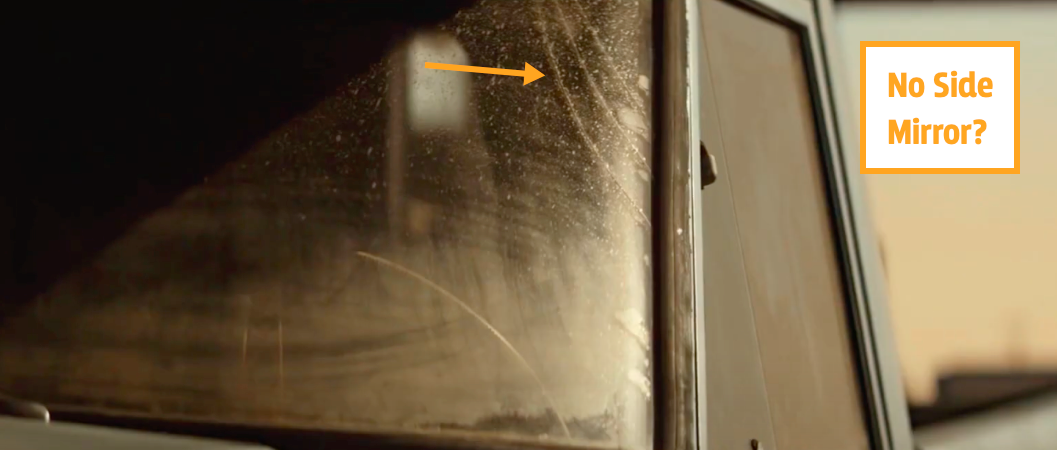
As the press lowers to crush the truck, we get a glimpse of a pickup with no side mirror. Plus, as you’ll notice above, there are three cracks in the windscreen, all roughly in line with the upper pivot-point for the quarter window. Those cracks look familiar:
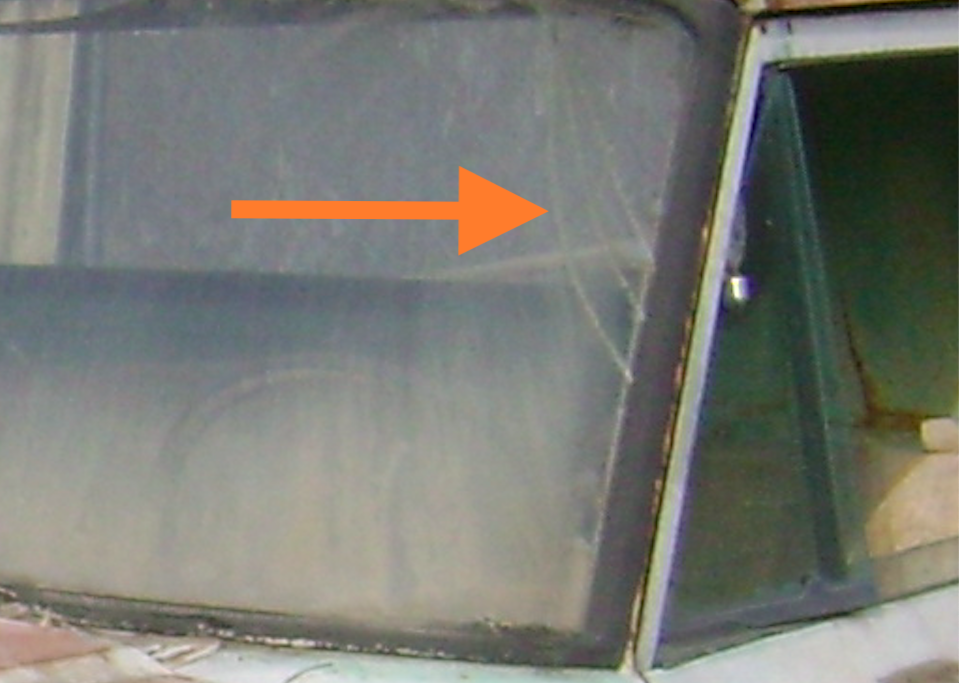
You’ll also notice in the image of Loren’s old truck above that there’s a bit of rust just outboard of the windshield seal. There appears to be some amount of corrosion on the truck in the commercial:

Right around this point in the commercial, we get a glimpse of the cab buckling from behind. Now, you’ll notice, the large rear window that the truck had at the beginning of the commercial is small, like on Loren’s truck:

There aren’t any telltale signs showing that the truck in the scene above is Loren’s, as the rust and irregular paint patterns on Loren’s Gladiator don’t exist on the truck in the commercial. Perhaps Jeep cleaned this up, either physically or digitally:
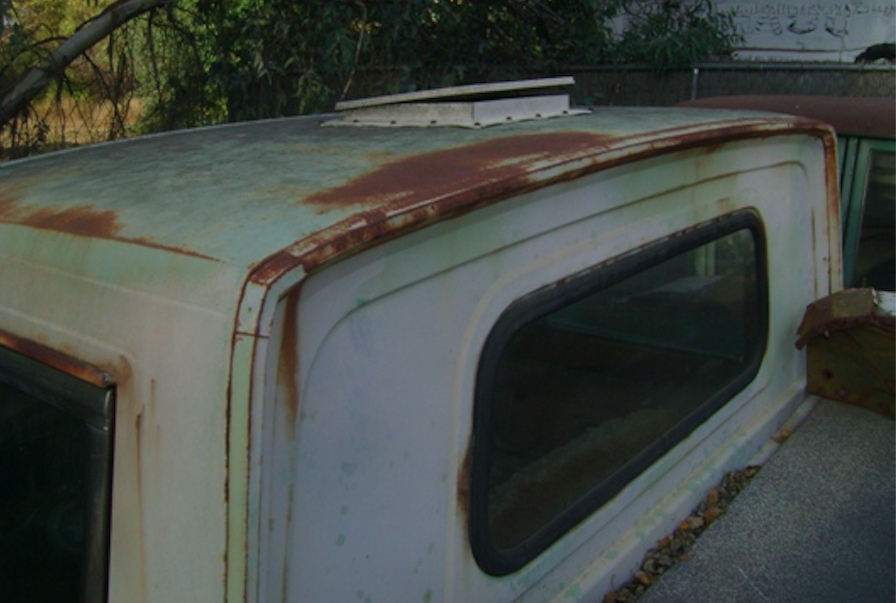
Later in the commercial, just as the press crushes the Gladiator into a pancake, and just before the rare first-model-year Jeep turns into a new Gladiator that fends off the powerful press, we see this shot:
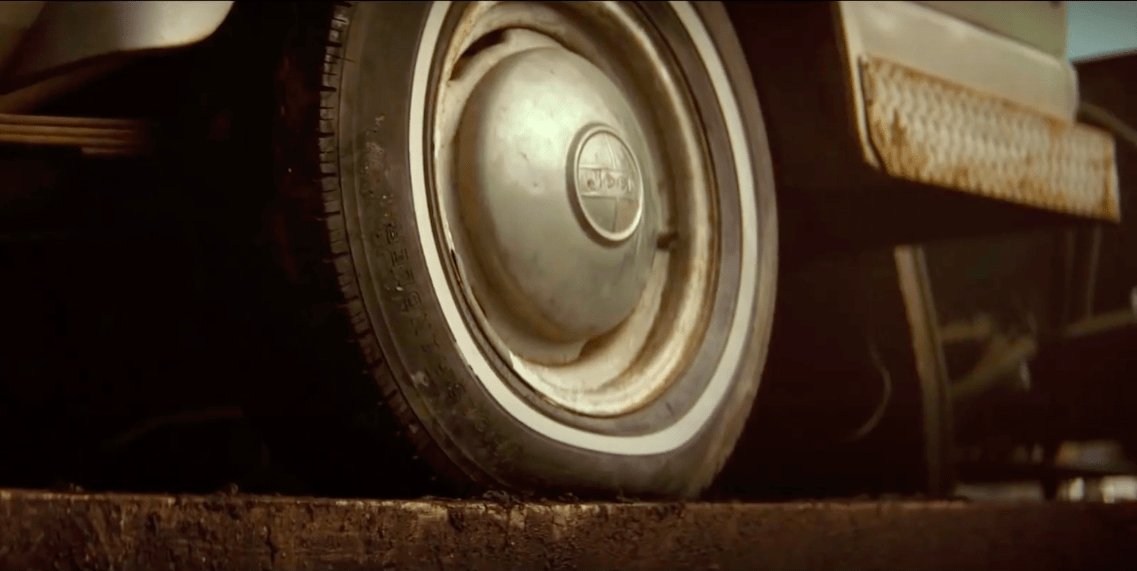
Notice the hubcap, tire, and especially the rear bumper. They’re a perfect match for Loren’s truck.
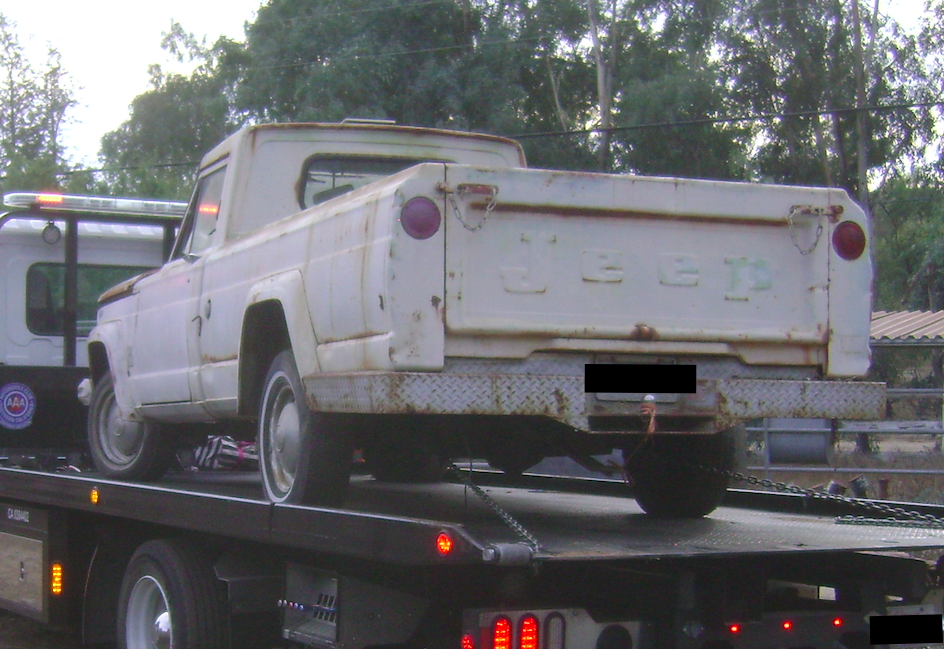
Let’s zoom in a bit on that rear bumper. Check out that star-shaped rust spot on the driver’s side.
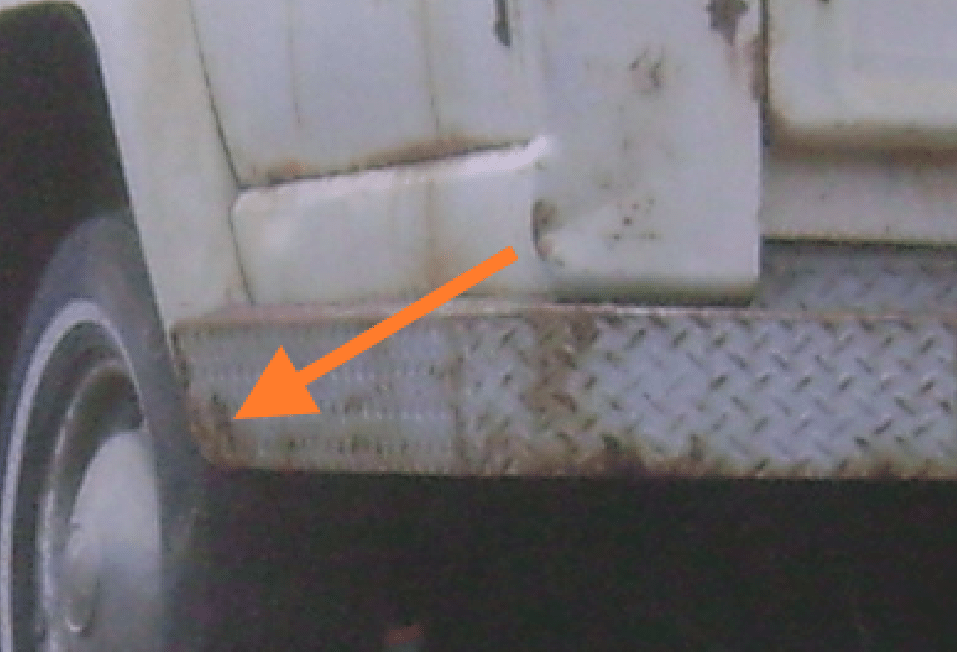
Notice how it perfectly matches the location of a similarly-shaped rust star found on the aftermarket bumper of the truck in the commercial:
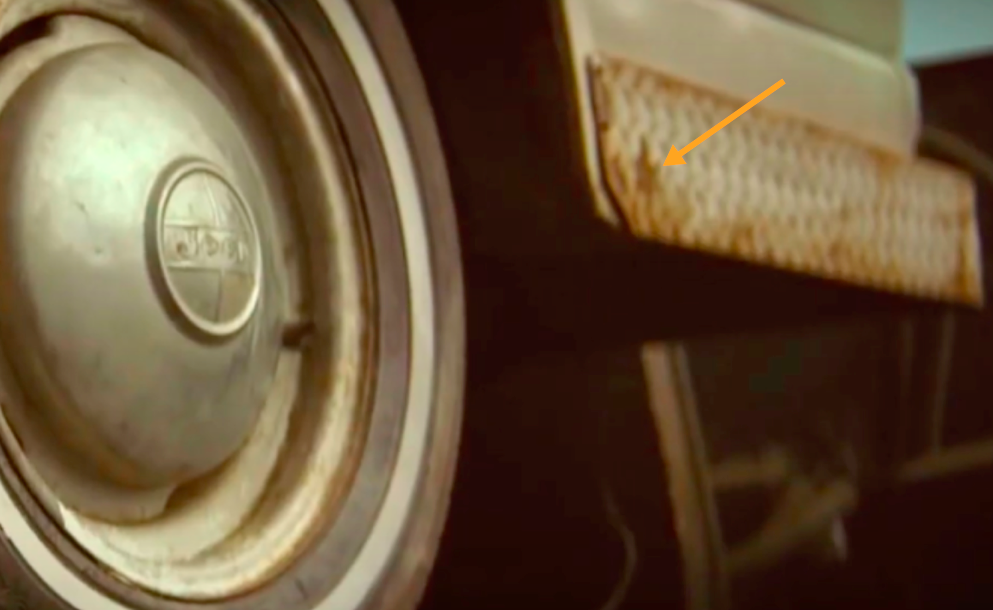
This is clearly Loren’s old truck, and should there still be any doubt, Loren, a San Diego area-resident, sent me his correspondence with the person who bought the vehicle. That person works in the field of commercial film production, and when I asked a Jeep representative how the company had obtained the Gladiator in the commercial, the P.R. spokesperson confirmed: “The vehicle was sourced via online through the brand’s creative agency.”
The famous crushed 1963 Jeep Gladiator belonged to a San Diego-area man named Loren; he tells his full story of the now-dead classic in the paragraphs below:
The Truck’s Previous Owner Tells His Story
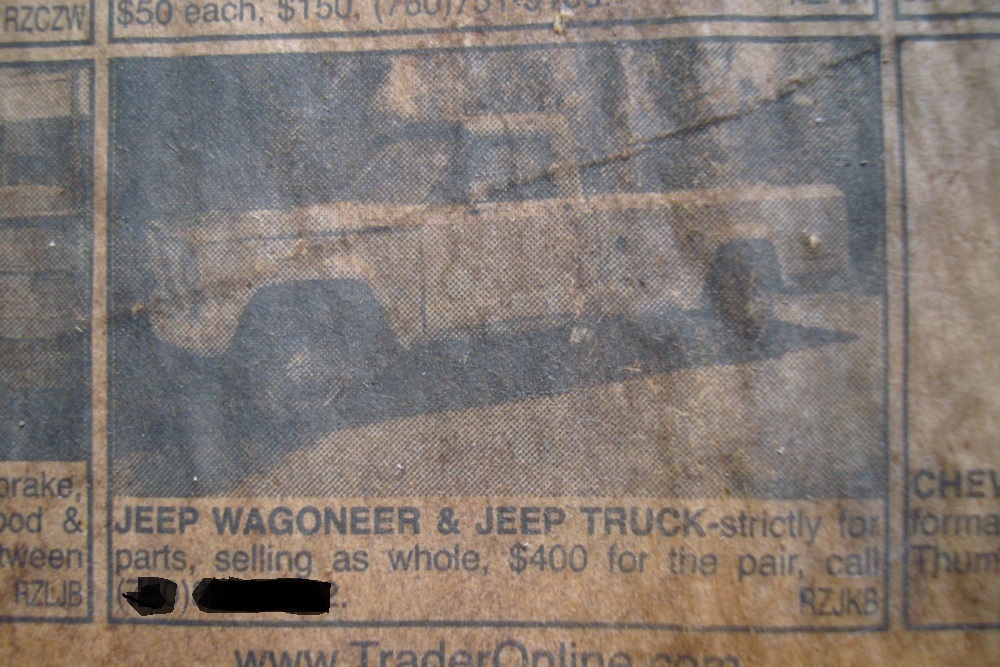
Loren Hunts For A Clutch Pedal For His Wagoneer
To: David Tracy
Jalopnik, The Internet
Dear Mr. Tracy,
Following is the story of how Jeep crushed my pickup truck.
It all started with a clutch pedal, for a Jeep Wagoneer, or rather my needing one. In the Summer of 2003 I knew nothing about what they call “full-size” Jeep pickup trucks and station wagons beyond kind-of liking them and having owned the Tonka Toy versions as a kid, but after staring at a friend’s dead ’78 Wagoneer long enough I decided his abandoned project should be mine. Once getting it home however, I didn’t think that the challenge of fixing the broken auto trans/Quadra-Track 4WD system was quite for me, and maybe instead some of the Chevy manual trans stuff I had around would work plus be more cool. All I would need that I didn’t have was a clutch pedal.
No junkyards had one, by then the Wagoneers there were all leather interior-aluminium wheeled luxury cruisers, unlike the older more-basic cars, with not a manual trans to be had. So, I turned to the local print Auto Trader and by luck the first issue I picked up had my clutch pedal…probably. Deep in the classifieds was a Jeep truck offered for parts but to be sold complete only and as a pair along with another Wagoneer, not exactly the deal I needed but it looked in the photo like maybe it would be old enough to have a stick shift. Knowing the stipulations I called anyway and the guy said to just come look. Titles, by-the-way, were long-gone.
Going To Purchase A Wagoneer For Parts
From my home NE of San Diego CA it was about an hour to the town of Fallbrook in the hills inland from the Camp Pendleton Marine base along the Pacific Ocean. At the address the house was like a time capsule from the fifties with features that must have been modern style then, but now all was decrepit with peeling paint and trash strewn across the dirt yard. A crew was tossing junk into a roll-off dumpster, the person I spoke to who placed the ad was apparently the supervisor and he said the homeowner was some old guy who lost his mind or died or something and they were just hired to clean the place out. About then a very nice Bridgeport milling machine was being slid out of a garage attached to the house. There had been more large machines, he said. The old man must have been some kind of engineer to have that at home, maybe with the aircraft industry which flourished nearby during WWII and a few decades afterward; there would be no way to know.
The truck was down a hill off to the right but I walked past it to see the Wagoneer which was peeking out from behind a shed with a genuine old-style square grill like I hadn’t seen for a long time. It must have been one of the first models made and had added-on neat little gadgets like a compass etc., plus machined covers over the front wheel hubs probably made on that Bridgeport. Somebody’s baby, once. The last tags were from 1986. The front doors didn’t quite match in colour and looked like they had been replaced. It was stick shift, with a clutch pedal! I decided then and there that should be my project, the whole car, instead of the ‘78. When messing around with old cars, older-yet can be better.
Seeing The Truck For The First Time. The Body Looked Decent
Only then did I go see the truck. It was one homely-looking rig, that square grille again with vertical slats, the cab and bed also made up of angles with a tallish roof that included an awkward brow over the windshield, and metal fender flares with a combination of rounded and angled shapes that added a couple inches in width to each side. Jeep called them “Gladiators” although there were no such emblems saying so. It had tiny D-78-15 tires lost in those fenders and no 4WD, just rear-drive only. I could see where the Wagoneer doors had come from, that cars’ originals, both bashed in, were here now. Some instrument panel parts were missing but it was otherwise complete. Under chalky white paint there was Forest Service Green, probably originally it had been used by that agency, a guess supported by its’ lack of options except big mirrors and having a large steel step-plate rear bumper. Somebody had installed an RV-type roof vent over the cab. There was no serious rust for all its’ years sitting, mostly just a couple bad spots on the floors and a bit of thin stuff on the surface. The tags were from a few years older than the Wag on a CA licence plate with a Chevy dealer’s frame, probably they bought it at auction and painted it up cheap to sell on their used car lot. The steering was horrifically loose, the long tie rod in front of the straight-axle nearly falling off and likely the reason it stopped being driven back whenever. After that it must have only been used for a few parts to support the more-favoured Wag.
Inside the driver door I examined the VIN tag. “Willys Jeep” it said. I’d had no idea that those new-for-’63 trucks were from the Willys era, the original company making Jeeps before Kaiser and then AMC (and later Chrysler). I imagined what it must have looked like new, marching out of some mid-west factory with its’ brothers to serve in oil fields, with contractors, or the government. Besides that of its’ purchasers, the Gladiator represented the hopes and dreams of the entire Willys company, as their investment in making them must have been huge. Could its builders have imagined then that their design would go on to serve practically un-altered for nearly thirty years?
He Saved It From The Crusher
I had to ask the man about my just taking home the Wag, he said “Sure” but the price was the same $US400 ($525) as if I’d bought both. What was going to happen to the truck if I didn’t take it? Nobody else beside me had come, so it would be going to scrap the next day. In the time I had spent checking it out, the old beast had grown on me enough that I was pained to think of it being crushed for scrap metal after surviving all that while so I committed to both vehicles. The next morning during the hottest weather of the year my friend Jake borrowed a ramp truck and trailer and we spent much of the day dragging the two non-running Jeeps from their holes down a steep hill. For temporary we dropped them into his back yard until I could shift things around a bit at home. Jake’s brother, also an old-car enthusiast, happened along and expressed amazement. “Yeah, cool old Wagoneer huh!” I said. His reply was that it was the truck he thought was so great.
Life Got In The Way Of Restoration Plans, Loren Searched For A Good Home For His Gladiator
A couple years went by and with my learning more about all kinds of Jeep facts and history from that new internet thing, I picked up more early full-size Jeeps including a 4×4 Wagoneer also from the Willys era and even a wrecked Kaiser military M-715 for prices of around a couple-hundred each, with me remembering when musclecars were cheap and then became gold. (I should mention I have a very-tolerant wife, and neighbours.) What I came to picture was an early Wagoneer and then that truck sitting restored at the top of my driveway like a matched set, one for a family hauler and one for me to go get plywood in or hit the Cars & Coffee with something really unique.
However, life went on while daily matters took precedence and the Jeep projects sat with my always needing vehicles that ran right-then. Periodically I put an ad in the classifieds, Craigslist now, for full-size Jeeps or parts as I had plenty of extra and someone would come by and grab something they needed, but the truck was to stay intact. Like a pet owner wanting to send their little luv to a “good home” only, if I sold it I was looking for someone who would care for it and hopefully do a restoration. I didn’t save that thing from the junkyard and then store it in my yard for all that time only to see it parted out.
A Mysterious Person Offers $US2,000 ($2,627) For The Junker
It was around Thanksgiving 2017, 14 years from when I’d hauled the two FSJ’s home, that I placed one of those ads again expecting I’d get little response so close to Christmas with everyone’s money tight. I offered-up the entire lot of Jeeps this time just to see what would happen. I was soon contacted about the truck specifically, again it was the truck that people liked. For it alone I was only looking to make back the $US200 ($263)-plus-expenses I figured I had into it…maybe $US500 ($657)? The guy was agreeable and would come see it on the weekend a few days later.
And then, this:
From: [The eventual buyer]:
“Hello,
Interested in your lot of Jeep parts. Please let me know if the items are still available.
Thanks
My response:
“It seems as though I may have been talked into selling the pickup truck only, out of the bunch…this is still up in the air and we won’t know for a few days.
What I’d call the ‘63 Willys Wagoneer w/ ‘64 Kaiser Wag for parts is available, and also the ‘69.
I am treating interest as first-come, first serve so if you have any specific thoughts let me know.
-Loren”
And then, from [The eventual buyer]:
“We also are mostly interested in the truck, I will need to get an approval but will know earlier in the day tomorrow. Upon approval we would be willing to beat the current offer.
Thanks,”
I wrote:
“Thanks for message, if current deal which I’ve given my word to winds up shaky on the buyer’s end then let’s talk, and I can send more pics then. For now I’ll consider you next in line in any event.
-Loren”
[The eventual buyer] replied:
“Hello Loren,
I realise you have already given your word to someone, but if you can reach out to them because we would like to offer 2000.00 cash and pick it up tomorrow afternoon.
Thanks”
Two Thousand dollars? Tomorrow afternoon? I sent [the person] more photos showing the truck plus applicable comments. [The person] replied:
“Hello Loren,
Thank you for sending along all of this detailed information, I will forward along to my guys to look over, but we are still very interested so as soon as you hear back from the other interested parties please let me know so we can move forward on finalising this deal.
Thank you”
It Turns Out, The Buyer Worked For A Media Company
Out of curiosity and since I had a full name to go by, I did a Linked In search. The person was from a media company in the San Fernando Valley of Los Angeles, an area I grew up around. Lots of television and movie stuff happens there. Maybe my old truck that was suddenly so desired was about to be a prop in a movie, or the star of some new Overhaullin’-type TV show? I thought to inquire but figured [the person] wouldn’t say. If [the person] was going to offer any kind of story, [the person] would do it on [their] own.
With an odd feeling in my gut I contacted the first guy and said, “We have a problem”. I told him, “Here’s what you’re paying, here is what I’ve just been offered”, I had made a verbal deal with him to have the first shot and the truck was his if he wanted but now what I really wanted was to buy him out. He’d get a couple-hundred bucks from somebody he’d never met for doing nothing, and I’d have a few hundred more in my pocket for the Holidays. He sounded resigned. He had meant the truck for a project for his dad and was sorry he hadn’t come right over. In any event he didn’t want anything from me. That whole exchange would haunt me.
I wrote [The eventual buyer]:, in short:
My other interested party is very disappointed but is agreeable. The truck needs to be dragged out, parts removed from bed, doors swapped and sat on inflated tires which I shall get to doing. You have the photos and information from me so no hopefully no surprises, we want everybody to be happy here. You are aware of the title situation, will bring along or compose any documentation you wish me to sign, price is $US2000 ($2,627) and of course all CL deals are cash.
Maybe let me know some details from your end so we can figure time and I know what to expect.
-Loren
[The eventual buyer] now:
Awesome!!! Thanks Loren. We are working out the details of transporting the vehicle. As soon as I get all that info lined up I will be in touch with an estimated time of arrival.
I sent [the person] some directions and what a good time window would be.
The Buyer Hauls The Gladiator Away
The next morning, since the buyer was paying all that money, I took the good doors off the Wagoneer that had sat near the truck for so long both in Fallbrook and here and put them back where they came from. I replaced a couple wheels with ones that had tires that would hold air, made sure there was a full set of little round hubcaps on, and washed away tree leaves and dirt. I considered removing the cool original grill emblem and dropping it in my pocket but no, it was in the ad photo and I was feeling slimy enough already, so I left it there. Without the buyer ever having actually seen the Jeep, around noon a shiny Triple-AAA roll-back tow truck pulled into my yard with the driver confirming my suspicion that nobody would be talking about what the plans for the truck were but holding an envelope of $US100 ($131) bills. In a few minutes the tow and my old 1963 Full-Size Jeep truck were gone up the road. The ride from San Diego to the north end of Los Angeles must have cost the buyer half what was being paid for the Jeep.
A few hours later I got a note:
“Received, thank you!”
Then a little later yet:
“Hello Loren,
Thanks for the beautiful jeep, everyone is very excited about it.”
[The person] then went on to ask about another particular vehicle I might have some lead on and thanked me but I replied I didn’t know of anything and that was the end of that.
The Moment Loren Realises The Truck He Once Dreamed Of Restoring Has Been Crushed
Over the ensuing months I watched the TV here-and-there to see if my old truck should surface again. I watched for the new ICON builds. I noticed nothing and eventually forgot about it.
Toward the end of the following summer Kyle, an internet-friend of mine from the East Coast who is the age of my kids but shares my particular old-car bug, came into town off Navy deployment and thought we should hit up one of the local weeknight car cruises that certain cities have around here. After walking the length of the event and checking out all the cars, we sat at a footpath restaurant to have a cold I.P.A. and watch the goings-on. Catching up on things, I mentioned that I had sold the truck to some media company in L.A. and wondered if he’d seen anything of it. He looked blank.
The subject dropped, but then I noticed him peering down at his phone, pressing buttons, scrolling. He handed it to me.
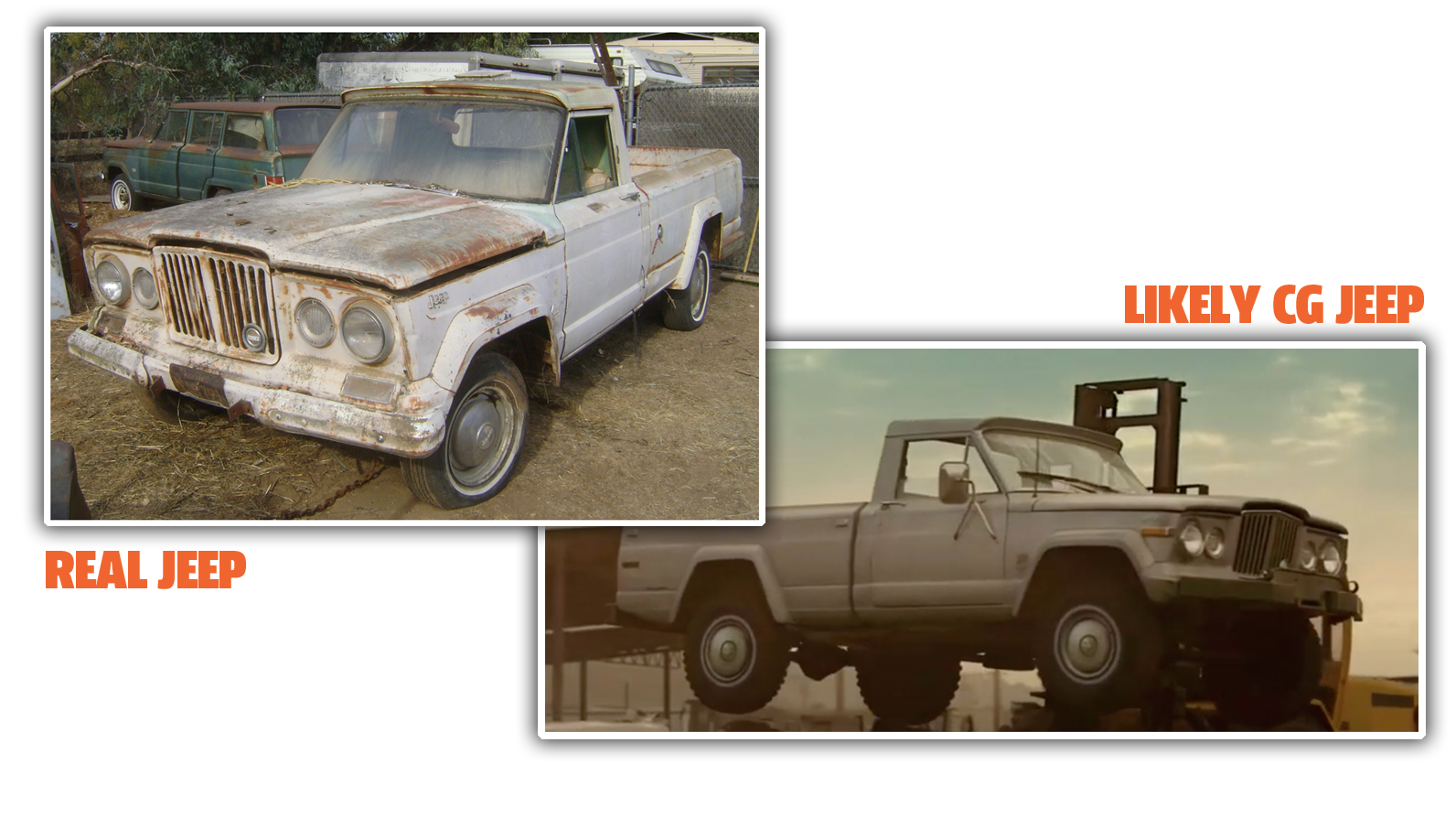
I was viewing what looked like a television ad. There was music, hard rocking but upbeat, and a forklift in a junkyard which was carrying an old, white full-size Jeep Truck. The tires and wheels were stock-looking, with little round hubcaps. The forklift placed the truck onto the deck of a huge machine, and the machine was a car crusher. The top came down, and shown in various views from various angles, the roof of the truck was pressed down, and then the bed… At the end of the crushing the images reversed, and with a little editing trick or two a sweet brand-new Wrangler-based truck emerged un-squished from the crusher, as if to be reborn.
Me: “Noooo……” I couldn’t believe my eyes.
Kyle was staring at me, as if to say “Dude, are you OK?” I pulled it together and watched the video again. On second glance I was relieved to see it actually appeared to not be “my” truck. Mine had a small back window (there were two sizes) and I saw one in the ad that was large. My old truck was still safe out there, one of the likely-very-few remaining restorable original Jeep Gladiator pickups did not just get crushed to make to make an ad for the new Wrangler-based Gladiator.
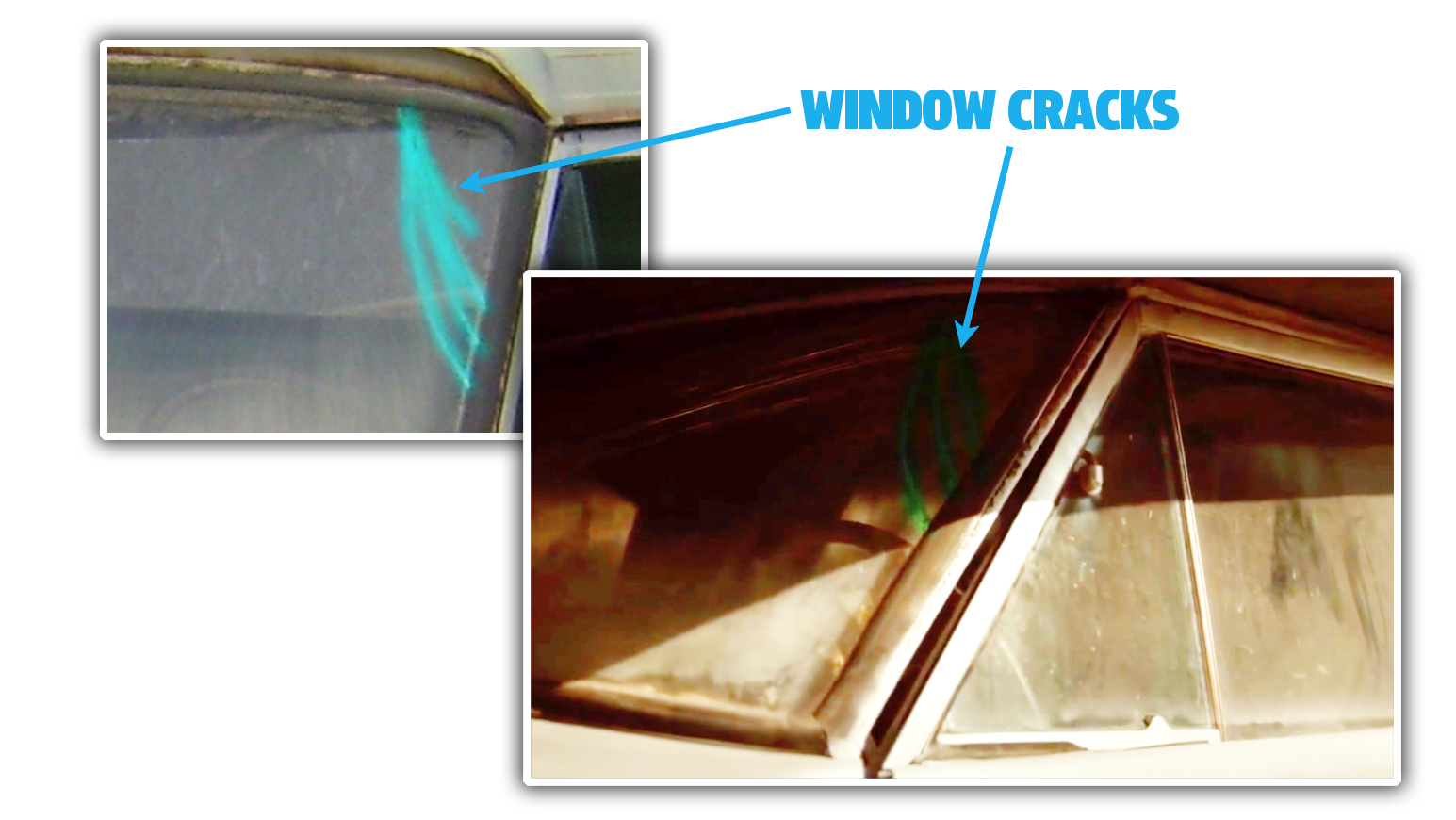
And that was where that stayed…for about a week. Then it started gnawing on me, what are the chances that the truck went to L.A. like that and then a couple months later there’s a video of almost exactly but not quite the same truck. Also, normally nobody does a scene in one take. I hit Kyle up for the link to the ad and got on my computer with the screen I can actually see something on. YouTube, it was right there. I watched the video again, closely, frame by…agonizing…frame. There had been a big back window, but then there was a small one. I compared a shot of the left rear quarter, with its’ step-plate aftermarket bumper and stains of rust, to photos of my old truck.
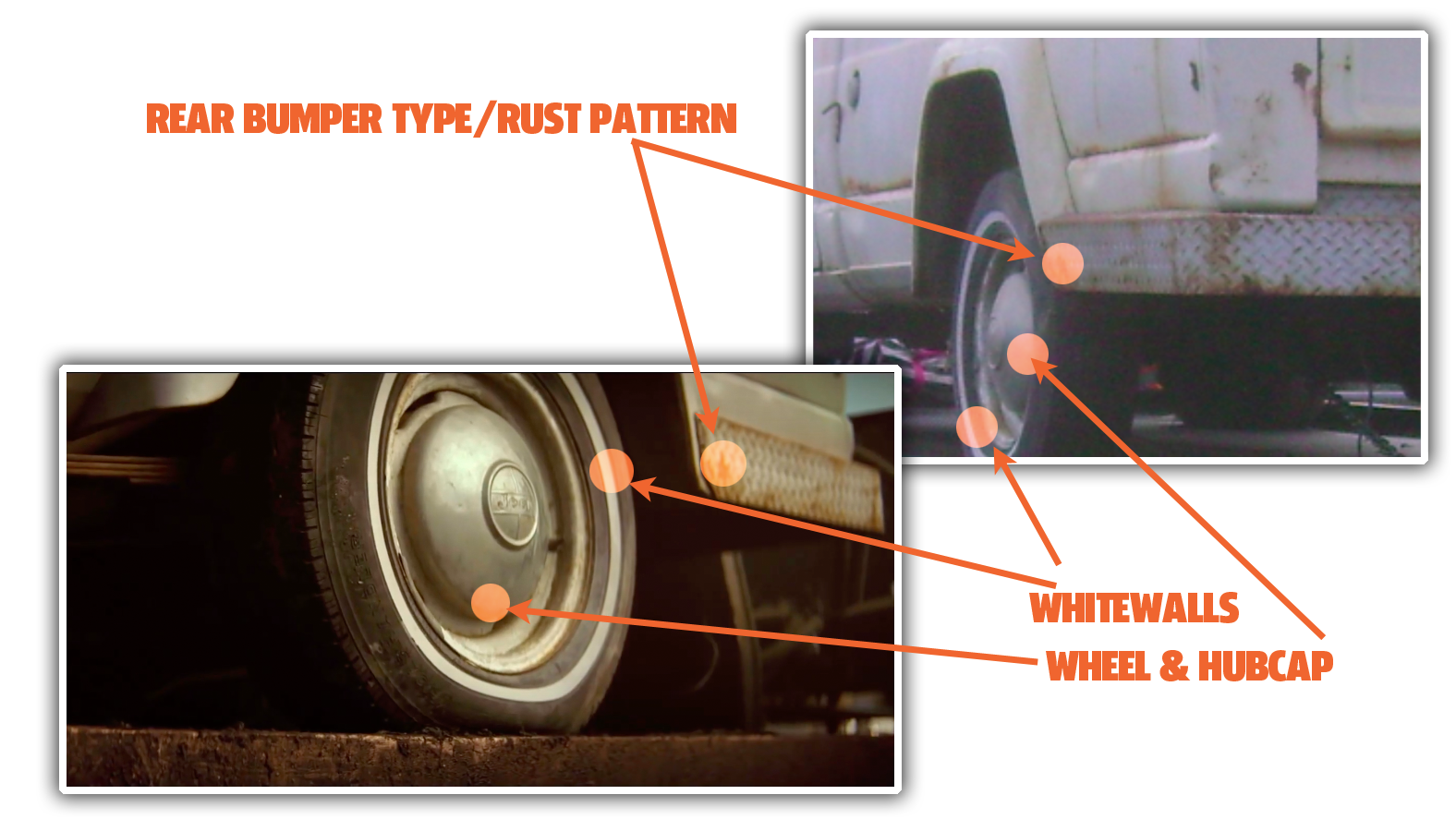
Yep, there it was. They had used two trucks. One a little newer and seen more predominately, and then mine. Where the back got crushed, the bed pushing down on the whitewall tire, and then in a subsequent scene at the :33 mark when it rose back up in reverse, it was clear. My photos and the ad matched rust-spot for rust-spot.
They really did crush my old ‘63 truck.
Loren makes it clear that he’s grateful to have made $US2,000 ($2,627) on this sale, and he’s not upset and in no way trying to make this a big deal. He just had a cool story to share. “Jeep or whoever was making the advertisement bought it with their money so it was theirs to do what they wished, and I had some extra bucks for the Holidays,” Loren wrote tome.
That said, Loren does understand why people are upset with Jeep’s decision to crush the old Gladiator, concluding his story with:
…there are ads for Chevy Suburbans that show old models through the years surrounded by people dressed in contemporary style looking like they’re having a good time, that promote their new vehicles while really seeming to celebrate tradition and history. Jeep did not celebrate tradition with that ad. They crapped on it.
…I sorta hope the gal who called it “beautiful” but who probably was the girl from grade school who asked to see my arts-and-crafts project then scrunched it up and threw it on the floor, had a bad day, maybe two. And after that I’d wish that someday, poking around in some junkyard as I like to do, I might come across my old Jeep pickup all crushed up like they did it. I’d say “I saved you once; I couldn’t save you a second time. At-least you got your fifteen minutes of fame”.
Maybe I’d grab the clutch pedal.
Best Regards,
Loren from San Diego
So it’s as the old-car enthusiasts feared: A restorable, classic 1963 Jeep Gladiator gave its life so that Jeep could make a commercial for a much-less-cool (but still cool) Wrangler-based 2019 Jeep Gladiator.
In some ways, it’s a shame, but this sort of thing happens all the time. People buy old classics and scrap them, or they turn those classics into dedicated off-road buggies with hacked-off panels and welded-on armour. Jeep itself has a history of buying beautiful classics and slicing them up to make them Easter Jeep Safari concept cars (though at least in that case, they live on in some form rather than rising to the great junkyard in the sky).
The reality is that people can do what they want with vehicles that they own, though I personally don’t plan to ever permanently alter or destroy a good example of a classic. In my mind, I’m a temporary owner, and to be a good steward of car culture, I need to make sure that I do what I can to keep timeless machines on the road. Even ones without titles and that, together with another Jeep, cost a total of only $US400 ($525).
Perhaps I’m being a bit too romantic.
In any case, pour out a quart of 10W-30 for the beautiful 1963 pickup that gave its life for a now-iconic ad.
